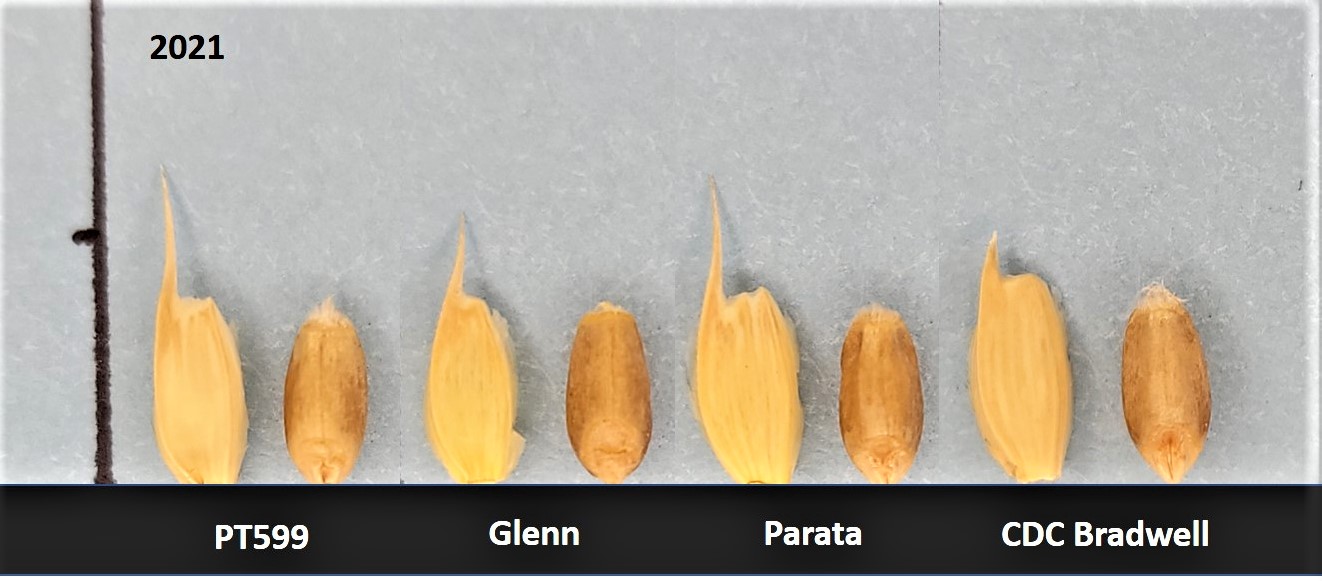CDC SKRush
| Denomination: | 'CDC SKRush' |
|---|---|
| Previously Proposed Denomination: | 'PT599' |
| Botanical Name: | Triticum aestivum |
| Applicant/Holder: |
University of Saskatchewan Crop Development Centre 4D36 Agriculture Building, 51 Campus Drive Saskatoon, Saskatchewan S7N 5A8 Canada |
| Breeder: |
Pierre Hucl, University of Saskatchewan, Saskatoon, Saskatchewan |
| Agent in Canada: |
SeCan Association 400-300 Terry Fox Drive Kanata, Ontario K2K 0E3 Canada Tel: 613-592-8600 ext.223 |
| Application Date: | 2020-07-29 |
| Provisional Protection:: | 2020-07-29 |
| Application Number: | 20-10325 |
| Grant of Rights Date: | 2024-02-01 |
| Certificate Number: | 6986 |
| Grant of Rights Termination Date: | 2044-02-01 |
Variety Description
Varieties used for comparison: 'Glenn', 'Parata' and 'CDC Bradwell'
Summary: At the 4 leaf stage, the coleoptile of 'CDC SKRush' has an absent or very weak intensity of anthocyanin colouration whereas that of 'Parata' has a weak intensity of anthocyanin coloration. At booting, 'CDC SKRush' has a medium frequency of plants with recurved flag leaves whereas 'Glenn' has a high to very high frequency of plants with recurved flag leaves. At maturity, the hairiness of the convex surface of the apical rachis segment for 'CDC SKRush' is medium to dense whereas it is sparse for 'CDC Bradwell'.
Description:
PLANT: spring type, common wheat, erect growth habit at 5 to 9 tiller stage, medium frequency of plants with recurved flag leaves, heads mid-season
SEEDLING (4-LEAF STAGE): absent or very weak intensity of anthocyanin colouration of coleoptile, glabrous sheath and blade of lower leaves
FLAG LEAF: medium intensity of anthocyanin colouration of auricles, weak glaucosity of sheath, glabrous blade and sheath
CULM: medium to strong glaucosity, curved neck
STRAW (AT MATURITY): pith of thin to medium thickness in cross-section, anthocyanin colouration absent
SPIKE: absent or very weak glaucosity at heading, tapering shape in profile, medium density, yellow at maturity, erect attitude, medium to dense hairiness of convex surface of apical rachis segment
AWNS: shorter or equal to spike length, white at maturity
LOWER GLUME: medium length and width, glabrous, medium extent of internal hairs
LOWER GLUME SHOULDER: medium to broad, slightly to moderately curved
LOWER GLUME BEAK: long, slightly to moderately curved
LOWEST LEMMA: straight
KERNEL: hard red type, medium red, medium size, medium length and width, oval shape, rounded cheek shape, medium to long brush hairs, crease of medium width and depth
GERM: medium sized, rounded or broad elliptical shape
Origin & Breeding History: 'CDC SKRush' (experimental designations PT599 and W13679) originated from a controlled cross conducted in Swift Current, Saskatchewan between the lines W04619 and W06023 in 2008. The resultant F1 progeny was grown in New Zealand during the winter of 2008-2009. The F2 generation was grown as a bulk plot in Saskatoon in 2009. The F3 generation was grown in bulk plots in a winter nursery in New Zealand during the winter of 2009-2010. The F4 generation was grown in bulk plots at the Viterra Research Farm in Rosebank, Manitoba in 2010 with one line designated as W13679. Subsequent generations were grown in plots and further selections were made based on yield, plant height, and straw length. The variety was evaluated in the Parkland Cooperative Test from 2016 to 2018 as PT599.
Tests & Trials: The comparative trials for 'CDC SKRush' were conducted at the University of Saskatchewan, Crop Science Field Facility during the 2020 and 2021 growing seasons. There were 4 replications per variety arranged in an RCB design. Plots consisted of 5 rows, each row 3.6 metres long with an inter-row spacing of 0.23 metres. Measured characteristics were based on 40 measurements per variety per year.
Click on image for larger view

Wheat: 'CDC SKRush' (left) with reference varieties 'Glenn' (centre left), 'Parata' (centre right) and 'CDC Bradwell' (right)
- Date modified: